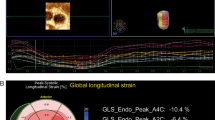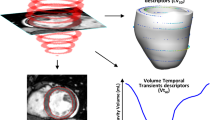Abstract
This study sought to compare regional measures of ventricular strain by tissue tracking (TT) to those derived from myocardial tagging (MT) within cardiac MR (CMR), in normal subjects and patients with hypertrophic cardiomyopathy. CMR images from 13 normal subjects and 11 subjects with hypertrophic cardiomyopathy were retrospectively analyzed. For each subject, equivalent mid-papillary level short-axis cine steady-state free precession and MT slices from the same examination were evaluated. The time to peak circumferential strain and magnitude of the peak strain were calculated for 6 matched left ventricular segments. Data from 24 slices (n = 144 segments) were compared. The mean difference between techniques in magnitude of peak strain and time to peak strain was 1 ± 9% and 1 ± 58 ms, respectively. The mean difference in the standard deviation of time to peak strain within a slice was 0 ± 19 ms (mean cardiac cycle duration 1,013 ± 204 ms). Bland–Altman analysis showed closer agreement in time to peak strain than peak strain magnitude. Measurements of segmental time to peak strain by TT and MT were in close agreement; agreement for the magnitude of peak segmental strain was more modest. The TT approach does not add to CMR examination time and may be a useful tool for the assessment of ventricular synchrony.




Similar content being viewed by others
References
Gorcsan J III, Oyenuga O, Habib PJ et al (2010) Relationship of echocardiographic dyssynchrony to long-term survival after cardiac resynchronization therapy. Circulation 122:1910–1918
Wald RM, Redington AN, Pereira A et al (2009) Refining the assessment of pulmonary regurgitation in adults after tetralogy of Fallot repair: should we be measuring regurgitant fraction or regurgitant volume? Eur Heart J 30:356–361
Ortega M, Triedman JK, Geva T, Harrild DM (2011) Relation of left ventricular dyssynchrony measured by cardiac magnetic resonance tissue tracking in repaired tetralogy of fallot to ventricular tachycardia and death. Am J Cardiol 107(10):1535–1540
Attili AK, Schuster A, Nagel E, Reiber JH, van der Geest RJ (2010) Quantification in cardiac MRI: advances in image acquisition and processing. Int J Cardiovasc Imaging 26(Suppl 1):27–40
Markl M, Reeder SB, Chan FP, Alley MT, Herfkens RJ, Pelc NJ (2004) Steady-state free precession MR imaging: improved myocardial tag persistence and signal-to-noise ratio for analysis of myocardial motion. Radiology 230:852–861
Helm RH, Lardo AC (2008) Cardiac magnetic resonance assessment of mechanical dyssynchrony. Curr Opin Cardiol 23:440–446
AlJaroudi W, Chen J, Jaber WA, Lloyd SG, Cerqueira MD, Marwick T (2011) Nonechocardiographic imaging in evaluation for cardiac resynchronization therapy. Circ Cardiovasc Imaging 4:334–343
Fischer SE, McKinnon GC, Maier SE, Boesiger P (1993) Improved myocardial tagging contrast. Magn Reson Med 30:191–200
Haber I, Metaxas DN, Axel L (2000) Three-dimensional motion reconstruction and analysis of the right ventricle using tagged MRI. Med Image Anal 4:335–355
Ryf S, Kissinger KV, Spiegel MA et al (2004) Spiral MR myocardial tagging. Magn Reson Med 51:237–242
Haber I, Kikinis R, Westin C (2001) Phase-driven finite element model for spatio-temporal tracking in tagged MRI. In: Niessen WJ, Viergever MA (eds) Medical image computing and computer-assisted intervention. Utrecht, The Netherlands, Springer, Berlin, pp 1332–1335
Chung ES, Leon AR, Tavazzi L et al (2008) Results of the predictors of response to CRT (PROSPECT) trial. Circulation 117:2608–2616
Hor KN, Gottliebson WM, Carson C et al (2010) Comparison of magnetic resonance feature tracking for strain calculation with harmonic phase imaging analysis. JACC Cardiovasc Imaging 3:144–151
Schuster A, Kutty S, Padiyath A et al (2011) Cardiovascular magnetic resonance myocardial feature tracking detects quantitative wall motion during dobutamine stress. JCMR 13:58
Koopman LP, Slorach C, Hui W et al (2010) Comparison between different speckle tracking and color tissue Doppler techniques to measure global and regional myocardial deformation in children. J Am Soc Echocardiogr 23:919–928
Bansal M, Cho GY, Chan J, Leano R, Haluska BA, Marwick TH (2008) Feasibility and accuracy of different techniques of two-dimensional speckle based strain and validation with harmonic phase magnetic resonance imaging. J Am Soc Echocardiogr 21:1318–1325
Bilchick KC, Dimaano V, Wu KC et al (2008) Cardiac magnetic resonance assessment of dyssynchrony and myocardial scar predicts function class improvement following cardiac resynchronization therapy. JACC 1:561–568
Wald RM, Haber I, Wald R, Valente AM, Powell AJ, Geva T (2009) Effects of regional dysfunction and late gadolinium enhancement on global right ventricular function and exercise capacity in patients with repaired tetralogy of Fallot. Circulation 119:1370–1377
Maret E, Todt T, Brudin L et al (2009) Functional measurements based on feature tracking of cine magnetic resonance images identify left ventricular segments with myocardial scar. Cardiovasc Ultrasound 7:53
Petrini J, Yousry M, Rickenlund A et al (2010) The feasibility of velocity vector imaging by transesophageal echocardiography for assessment of elastic properties of the descending aorta in aortic valve disease. J Am Soc Echocardiogr 23:985–992
Koopman LP, Slorach C, Manlhiot C et al (2011) Assessment of myocardial deformation in children using Digital Imaging and Communications in Medicine (DICOM) data and vendor independent speckle tracking software. J Am Soc Echocardiogr 24:37–44
Chen J, Cao T, Duan Y, Yuan L, Yang Y (2007) Velocity vector imaging in assessing the regional systolic function of patients with post myocardial infarction. Echocardiography 24:940–945
Acknowledgments
Funding was provided by the National Institutes of Health Loan Repayment Program for Pediatric Research.
Conflict of interest
None.
Author information
Authors and Affiliations
Corresponding author
Rights and permissions
About this article
Cite this article
Harrild, D.M., Han, Y., Geva, T. et al. Comparison of cardiac MRI tissue tracking and myocardial tagging for assessment of regional ventricular strain. Int J Cardiovasc Imaging 28, 2009–2018 (2012). https://doi.org/10.1007/s10554-012-0035-3
Received:
Accepted:
Published:
Issue Date:
DOI: https://doi.org/10.1007/s10554-012-0035-3




